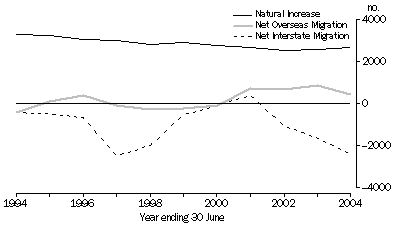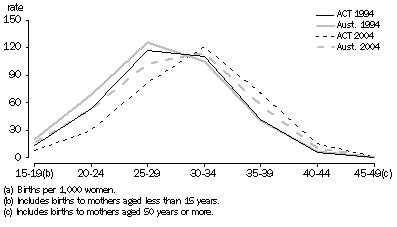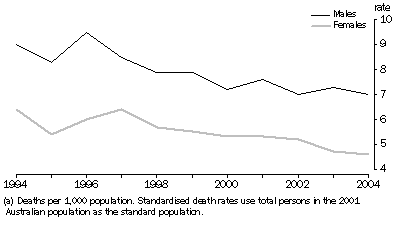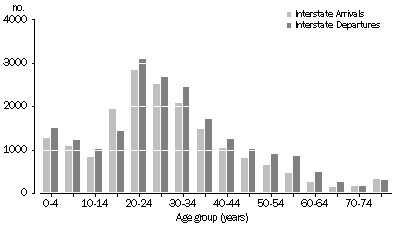NOTES
OVERVIEW
This is the final issue of this electronic product. It is intended that future state and territory-specific data will be made available in spreadsheet format with releases of the relevant annual national publications.
This electronic product provides a demographic overview of the Australian Capital Territory, 2004. It contains summary tables and commentary on trends in the components of population change including births, deaths and migration. Marriages, divorces, estimated resident population and various demographic rates are also presented. Population and migration data are for the year ended 30 June 2004, while births, deaths, marriages and divorces data are for the year ended 31 December 2004. More recent data are released quarterly in Australian Demographic Statistics (cat. no. 3101.0).
For comparisons between the states and territories of Australia, please refer to Demography, Australia, 2004 (cat. no. 3311.0.55.001). Demography publications for each state and territory can be accessed from the Related Information tab at the top of this page. Additional state demographic data are also available from publications and data cubes linked at the top of this page. The Demography Theme Page provides links to other Australian as well as international demographic statistics. The National Regional Profiles provide economic and social statistics of Statistical Local Areas and Local Government Areas of Australia.
INQUIRIES
For further information about these and related statistics, contact the National Information and Referral Service on 1300 135 070 or Neil Scott on Canberra (02) 6252 5997.
SUMMARY COMMENTARY
POPULATION
At 30 June 2004 the estimated resident population for the Australian Capital Territory (ACT) was 324,100 persons (160,300 males and 163,800 females). This represented a population increase of 7.5% over the last decade from 301,500 persons in June 1994. The ACT accounted for 1.6% of the Australian population in June 2004.
POPULATION COMPONENTS, ACT - 1994-2004

The annual population growth rate of the ACT in 2003-04 was 0.2%, which was lower than the national level (1.1%). Overall the ACT increased by 760 persons, as a result of natural increase (2,700 persons), net overseas migration (460 persons) and net interstate migration (-2,400 persons). Natural increase was the result of 4,200 births outnumbering 1,500 deaths. This was 3.1% higher than the level of natural increase experienced in 2003 (2,600 persons), and 18.2% lower than in 1994 (3,300 persons).
POPULATION AND HOUSEHOLDS, ACT - Selected years at 30 June |
|  |
 |  |  | 1994 | 2003 | 2004 |  |
|  |
| Estimated resident population | ('000) | 301.5 | 323.4 | 324.1 |  |
| Components of population change(a) |  |  |  |  |  |
 | Natural increase(b) | no. | 3 290 | 2 610 | 2 692 |  |
 | Net overseas migration | no. | -418 | 885 | 456 |  |
 | Net interstate migration | no. | -426 | -1 644 | -2 392 |  |
| Total increase(a)(c) | no. | 2 184 | 1 851 | 756 |  |
| Annual growth rate(a) | % | 0.73 | 0.58 | 0.23 |  |
| Estimated resident households(d) | ('000) | 108.0 | nya | nya |  |
| Projected households(e) | ('000) | . . | 124.2 | 126.3 |  |
|  |
| . . not applicable |
| nya not yet available |
| (a) From 30 June of previous year. |
| (b) Excess of births over deaths. Births and deaths figures used to compile natural increase for population estimates are based on year of occurrence and may differ from births and deaths data based on year of registration displayed in the Births and Deaths sections of this paper. |
| (c) Includes intercensal discrepancy not accounted for by natural increase and net migration. |
| (d) Based on 1996 census data. |
| (e) Series II from Household and Family Projections, Australia, 2001-2026 (Cat. no. 3236.0). |
BIRTHS AND CONFINEMENTS
In 2004 there were 4,200 live births registered to mothers usually resident in the ACT. This was an increase of 1.1% from the number of registered births in 2003 (4,100 births), and a decrease of 6.4% from the number recorded in 1994 (4,500 births). There were 2,200 male births and 2,000 female births registered in 2004, resulting in a sex ratio at birth of 106.8 males per 100 females.
There were 3,000 nuptial births and 1,200 exnuptial births in the ACT in 2004. During the period 1994 to 2004, nuptial births decreased 11.9% while exnuptial births increased 11.4%. Nuptial births accounted for 72.2% of all births in the ACT in 2004 which was higher than the national proportion of nuptial births (67.8%).
The ACT's total fertility rate (TFR), that is the number of children a female would bear during her lifetime based on current age-specific fertility rates, increased from 1.60 children per woman in 2003 to 1.64 in 2004. Although the TFR has increased consecutively for the last three years, ending a trend of long-term decline, it remained below replacement level (2.1) and was the lowest of the states and territories.
BIRTHS AND CONFINEMENTS, ACT - Selected years(a) |
|  |
 |  |  | 1994 | 2003 | 2004 |  |
|  |
| Live births |  |  |  |  |  |
 | Number | no. | 4 461 | 4 128 | 4 174 |  |
 | Crude birth rate(b) | rate | 14.8 | 12.8 | 12.9 |  |
 | Total fertility rate(c) | rate | 1.708 | 1.603 | 1.637 |  |
 | Net reproduction rate(d) | rate | 0.844 | 0.769 | 0.779 |  |
| All confinements |  |  |  |  |  |
 | Number | no. | 4 416 | 4 071 | 4 086 |  |
 | Median age of mother | years | 29.4 | 31.0 | 31.6 |  |
| Nuptial confinements |  |  |  |  |  |
 | Number | no. | 3 383 | 2 962 | 2 943 |  |
 | Median age of mother | years | 30.1 | 31.6 | 32.3 |  |
 | Median age of father | years | 32.3 | 33.5 | 34.0 |  |
| First nuptial confinements |  |  |  |  |  |
 | Number | no. | 1 348 | 1 315 | 1 279 |  |
 | Median age of mother | years | 28.7 | 30.3 | 31.1 |  |
|  |
| (a) Year of registration. |
| (b) Births per 1,000 population. |
| (c) Births per woman. |
| (d) Daughters surviving to reproductive age per woman. |
In the ACT in 2004 the net reproduction rate (the average number of female births per woman during her reproductive lifetime taking into account mortality of female births who die before 'replacing' their mothers) was 0.78, below the replacement level of one.
The ACT continued to experience a trend towards parents having children later in life, with the median age of mothers registering a birth in 2004 reaching a high of 31.6 years, up from 29.4 years in 1994. The median age for fathers also reached a high of 33.4 years. Since 1997 women aged 30-34 years have recorded the highest fertility in the ACT and this trend continued in 2004, with 120 babies per 1,000 women in this age group. In 2004, fertility rates in the ACT were below the national rates for women aged under 30 years and above the national rates for women aged over 30 years.
AGE-SPECIFIC FERTILITY RATES(a), Australia and the ACT - 1994 and 2004

DEATHS
In 2004 there were 1,400 deaths registered of persons usually resident in the ACT, an increase of 16.4% from the 1,200 deaths in 1994. There were 740 male deaths and 680 female deaths.
The standardised death rate (SDR), which eliminates the effect of the changing age structure of the population, decreased between 1994 and 2004. In 1994 the SDR for the ACT was 7.6 deaths per 1,000 population, decreasing to 5.6 deaths per 1,000 population in 2004.
The SDR shows the difference experienced between male and female mortality, with 7.0 male deaths and 4.6 female deaths per 1,000 population in the ACT in 2004. In 1994 the SDR for males was 9.0 deaths per 1,000 population compared with 6.4 deaths for females.
In 2004 the ACT had the lowest SDR of the states and territories, at 5.6 deaths per 1,000 population. The ACT also recorded the lowest rate of any state or territory over the last three decades. In 1974 the Australian SDR was 12.6 deaths per 1,000 population while in 2004 it had fallen to 6.3 deaths per 1,000 population.
STANDARDISED DEATH RATES(a), ACT - 1994-2004

In 2004 both males and females in the ACT had the highest life expectancy at birth of all states and territories. A male born in the ACT in 2004 could expect to live to 79.7 years and a female to 83.9 years, compared to 76.5 years and 81.5 years respectively in 1994. The median age at death in the ACT in 2004 was 75.2 years for males and 80.8 years for females.
There were 30 infant deaths (the death of a live-born child who dies before his/her first birthday) in the ACT in 2004. The infant mortality rate (the number of infant deaths per 1,000 live births) was 6.9 in 2004, above the national rate of 4.7. Although infant mortality in the ACT has decreased considerably since the 1950s, following the national trend, it has shown volatility over the previous decade due to the small number of infant deaths recorded each year.
DEATHS, ACT - Selected years(a) |
|  |
 |  |  | 1994 | 2003 | 2004 |  |
|  |
| Number | no. | 1 222 | 1 414 | 1 423 |  |
| Crude death rate(b) | rate | 4.1 | 4.4 | 4.4 |  |
| Standardised death rate(c) | rate | 7.6 | 5.8 | 5.6 |  |
| Median age at death |  |  |  |  |  |
 | Males | years | 69.3 | 73.9 | 75.2 |  |
 | Females | years | 78.3 | 81.5 | 80.8 |  |
| Infant deaths |  |  |  |  |  |
 | Number | no. | 21 | 24 | 29 |  |
 | Infant mortality rate(d) | rate | 4.7 | 5.8 | 6.9 |  |
| Life expectancy at birth(e) |  |  |  |  |  |
 | Males | years | 76.5 | 79.2 | 79.7 |  |
 | Females | years | 81.5 | 83.8 | 83.9 |  |
|  |
| (a) Year of registration. |
| (b) Deaths per 1,000 population. |
| (c) Deaths per 1,000 population. Standardised death rates use total persons in the 2001 Australian population as the standard population. |
| (d) Deaths per 1,000 live births. |
| (e) From 1995 onwards expectation of life has been calculated using three years of data. |
MIGRATION
Net overseas migration to the ACT has shown considerable volatility over the last decade, fluctuating above and below zero. In the four years prior to 2001 the ACT recorded negative net overseas migration. In each year since 2001 the ACT has recorded positive net overseas migration, gaining 2,800 persons overall. In 2004 net overseas migration for the ACT was 460 persons.
In 2004 the net interstate loss from the ACT was 2,400 persons, compared with a loss of 1,600 persons the previous year. This loss was the result of 20,300 interstate departures exceeding 17,900 interstate arrivals. Over the past decade the only year in which the ACT gained population due to net interstate migration was 2001, resulting from the highest number of interstate arrivals during the decade.
Of all age groups in the ACT, the 15-19 year age group recorded the largest net gain in population due to interstate migration, increasing by 530 persons in 2004. The only other age group to experience a net gain was the 75 years and over age group, with 30 persons. All other age groups recorded losses through interstate migration, with the greatest loss being experienced in the groups aged 55-59 years (-390 persons) and 30-34 years (-350 persons).
NET INTERSTATE MIGRATION, ACT - year ended 30 June 2004

MARRIAGES
There were 1,700 marriages registered in the ACT in 2004, an increase of 10.3% from the previous year, and an increase of 3.5% from the number of marriages registered in 1994. Over the previous decade the crude marriage rate in the ACT has ranged from a high of 6.1 marriages per 1,000 population in 1997 to a low of 4.8 in 2003. The crude marriage rate in the ACT for 2004 was 5.3 marriages per 1,000 population.
The median age at marriage for ACT brides in 2004 was 28.9 years, an increase from 26.6 years in 1994. The median age of bridegrooms in the ACT also increased over this time from 28.9 years in 1994 to 30.9 years in 2004. For both males and females the peak age group for marriage was 25-29 years.
Marriages in which neither party had been previously married accounted for two thirds (67.8%) of registered marriages in the ACT in 2004. Marriages in which one party had been married previously accounted for 17.9% and marriages in which both parties were remarrying accounted for 14.3%.
The trend to cohabit prior to marriage continued in the ACT in 2004, with marriage data indicating that over three-quarters (78.1%) of couples cohabited before marriage. This proportion was higher than the national figure of 75.5%.
MARRIAGES, ACT - Selected years |
|  |
 |  |  | 1994 | 2003 | 2004 |  |
|  |
| Number registered | no. | 1 661 | 1 558 | 1 719 |  |
| Crude marriage rate(a) | rate | 5.5 | 4.8 | 5.3 |  |
| Median age at marriage |  |  |  |  |  |
 | Bridegroom | years | 28.9 | 30.9 | 30.9 |  |
 | Bride | years | 26.6 | 29.0 | 28.9 |  |
|  |
| (a) Marriages per 1,000 population. |
DIVORCES
In 2004 there were 1,600 divorces granted in the ACT (a decrease of 3.5% from the number granted in the previous year). This was 23.0% lower than the level of divorces granted in 1994 (2,100) which was the highest level recorded over the last decade. Divorce data for the ACT includes some persons who are not residents of the ACT, but live in surrounding regions (see paragraph 20 of the Explanatory Notes).
The median age at divorce continued to increase in 2004, for the ACT as well as Australia-wide. The median age increased to 43.4 years for males and 40.6 for females, an increase of 4.1 years for both since 1994. For couples divorcing in the ACT in 2004 the median duration of marriage was 13.1 years which was higher than the national median duration of 12.3 years. The median duration of marriage to separation was also higher in the ACT (9.7 years) than Australia overall (8.7 years).
In the ACT, 2004 was the first year in which the highest proportion of applications for divorce were joint applications, accounting for 38.3% of all divorces. Historically there have been more applications for divorce registered by wives than by husbands or joint applications. However, over the past decade there has been a decline in the proportion of wives applying for divorce. In 1994 wives accounted for nearly half (49.4%) of all applications for divorce while in 2004 wives accounted for just over one third (35.7%). Nationally, 41.0% of applications for divorce were made by wives, 31.0% by husbands and 28.0% were joint applications.
DIVORCES, ACT - Selected years |
|  |
 |  |  | 1994 | 2003 | 2004 |  |
|  |
| Number granted | no. | 2 071 | 1 652 | 1 595 |  |
| Median duration of marriage |  |  |  |  |  |
 | To separation | years | 7.8 | 9.6 | 9.7 |  |
 | To divorce | years | 11.1 | 12.8 | 13.1 |  |
|  |
RELATED LINKS
Demographic data for all Australian Capital Territory statistical local areas are available from the data cube linked on the Details tab at the top of this page.
From the Related Information Tab there are links to other releases providing more specific or in-depth analysis and information
 Print Page
Print Page
 Print All
Print All